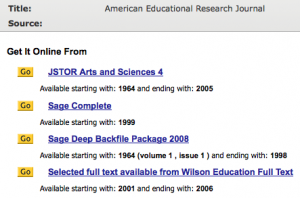What do you do with the stacks of journals you amass annually as part of your professional memberships? Use them? All of them? Add them to the “free take one” stack in your department’s mailroom? I recycle them on a quarterly basis, after perusing the Table of Contents and any potentially relevant articles. Do we need to receive print copies?
I’m going to use the American Educational Research Association (AERA) as an example of poor practice. Members automatically receive Educational Researcher and have the option of 1-2 additional journal subscriptions added for free. AERA does not offer members the option to receive current journals digitally. Environmentally, this practice is irresponsible, but the following text indicates a larger problem with AERA’s access to scholarship:
AERA is pleased to offer online access to the AERA journal archive — including full-text search capabilities — to members through a joint project with JSTOR. Access may be purchased at the low subscription price of $40 a year and is available only to current AERA members.
Journals in JSTOR have “moving walls” that define the time lag between the most current issue published and the content available in JSTOR. AERA journals have a five year “moving wall.” This means that the most recent issues available to AERA member JSTOR subscribers are from five years ago. The “moving wall” shifts each January when new issues are posted.
I have a problem with their five-year “moving walls.” As AERA describes, there’s a time lag. To impose a five year time lag for scholarship that likely took two years to publish is unacceptable.
Basically, anyone doing research who does not have access to the print publications must wait five years to access the articles. AERA is not alone in this publication practice, many well-established academic journals delay online publication.
Why?
What threats to intellectual property exist if an academic journal publishes its contents online? While I’d like to see this information freely available, let’s consider the question within the current confines of subscription-only library databases. What is so dangerous about publishing research, within the context of a peer-reviewed academic journal, online? Libraries and databases have already established a functioning profit model whereby articles are accessed through subscription or one-time payments. The research is already published and widely available in print, so availability/increased access shouldn’t threaten the intellectual property.
In fact, other print-based academic journals that do publish their articles within the database model send quarterly alerts that include the Table of Contents and links to the articles (with a subscribe or buy option, of course). I’m actually more likely to read these articles because (1) convenient access, (2) I can read them the way I usually read articles, print, highlight, and/or highlight in Adobe Reader, (3) they’re portable, and (4) I can organize them the way I usually organize articles, on my hard drive.
So, AERA, why the five year time lag?
I think we often fear what we don’t understand. Judging from their website, their clunky conference submission system, and their year-long delay in posting papers from their annual conference, AERA seems hesitant to enter the digital space. Regardless of the excuses, this digital ignorance is threatening educational scholarship. True scholarship is a dialogue, a sharing of information that advances our thinking. By limiting access to only those who receive the printed copies of a journal, AERA is, in effect, denying many scholars the opportunity to participate in this conversation.


